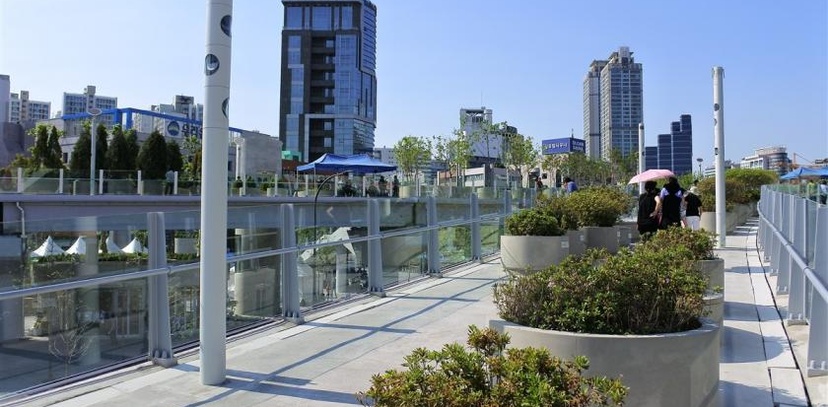
This blog by David Moynihan was first posted on Citymetric
Earlier this year saw the opening of Seoullo 7017. Seoul’s version of New York City’s high line is a 1970s elevated section of highway converted, by Dutch practice MVRDV, into a “Skygarden”: a pedestrianised walkway and garden, almost a kilometre long, landscaped with a wide variety of Korean plant species and illuminated at night.
The new landmark illustrates Seoul’s confidence as an emerging world city, a status first indicated by its hosting of the Olympic Games in 1988 and its hosting of matches during the 2002 World Cup. It is now considered the World’s most “wired city” and is also gaining a cultural prominence – something indicated by K-pop’s global success and other landmark buildings like Zaha Hadid’s Dongdaemun Design Plaza (DDP), which provides a modern counterpoint to several UNESCO World Heritage sites across the city.
The city is also facing several challenges. Like London and many other Western cities, Seoul is struggling with the growth of pronounced wealth inequality and a generational divide when it comes to accessing housing. It is afflicted by poor air quality, has an ageing population and growing mental health problems, affecting young people in particular. Since 2011, under Mayor Park Woon-son’s agenda, the city government has been looking to redress the balance in the city, through the encouragement of new social infrastructure and more direct forms of democracy. The byword for this work in Seoul is “revitalisation” rather than “reconstruction”, as place-making initiatives have taken precedence from building work.
An important programme in the city has been the conversion of 424 redundant local administrative offices for resident-led neighbourhood uses such as libraries, small theatres, concert halls and cafes. The success of this work will depend on the Ccty’s ability to engage and activate more residents, encouraging collaborative approaches to running local services and managing community spaces. This will help meet the mayor’s desire to develop the city’s social infrastructure, representing a switch in approach to managing the city, which had previously been focused on stimulating fast economic growth.
My social enterprise Social Life was invited – alongside Locality, the national network of community-led organisations – by the Seoul metropolitan government to share the UK experience of working with communities and, specifically, the mechanisms used help them play a more active role in their neighbourhoods. We visited two neighbourhoods in the city, Mapo and Mok 2 Dong, and heard from residents and small organisations working to improve their neighbourhoods.
In Mapo, on the western side of the city, running north of the Han River, we visited a site near the Olympic Stadium: a formerly disused oil storage facility, with six large oil tanks, converted into a new culture park used to promote eco enterprises and culture. We spoke to local residents’ who had been squatting on the site for live-work use. Residents had set up social and creative enterprises in shipping containers on the site, providing a range of services including affordable health, a flea market, a culture and arts festivals and eco-education. The city government’s first response was to seek to remove these illicit uses – but a change in heart saw it not only embracing these activities, but seeking to work with the residents on the design of the wider park.
Mok 2 Dong village.
Mok 2 Dong is a “maul” (village) in the Yangcheon District, again on the western side of the city but south of the Han River. It is an area of high-rise housing, including Hyperion Tower, one of the world’s tallest residential buildings – but we visited a lower rise section with street-level shops and cafes.
At a community café, we heard from Plus-minus 1°C, a social venture run by young villagers, which has led to the community cafe, as well as a village school, a housing co-op, and an annual town festival. The speed of this work and the energy and determination of the young people in making things happen in their neighbourhood was impressive
As part of our visit, we also spoke with a number of intermediary organisations, including research organisations, think tanks, sector specialists and neighbourhood support bodies. We heard about some of the issues they face when working with communities: difficulties in opening a dialogue with residents, encouraging residents to speak openly, reaching beyond the louder/stronger voices, and the perception that, as intermediaries, they were not seen as independent enough from government. Some familiar themes, but also some marked differences, from our experiences in the UK.
We sensed the impatience from the city government to usher in this new resident-led approach to the city’s revitalisation. Mayor Park Won-soon had previously spent time in the UK to collect ideas for his political project (both prior to and since becoming mayor), and he was impressed by the role of civil society in supporting the place-making process in cities like London. However, we offered a note of caution about the UK experience: the difficult message that community development was a slow and meandering process. We also emphasised that, for residents to form autonomous and lasting organisations serving their neighbourhoods, perhaps the best approach for local government is to step away and allow this process to occur naturally.